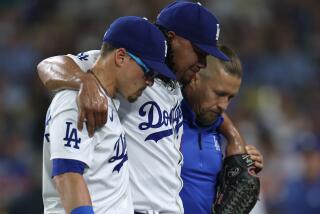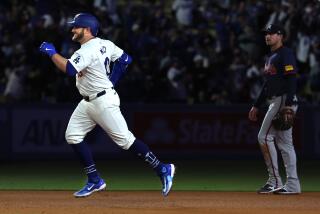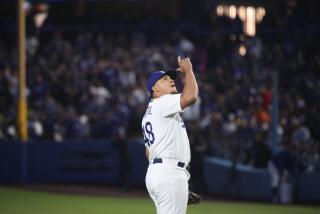The Big Cat Is Back
- Share via
KISSIMMEE, Fla. — For Andres Galarraga, the comeback began on a lonely back field at the Atlanta Braves’ spring training complex. He was accompanied by a handful of bats, a bag of balls and a couple of minor league coaches.
“I like it this way,” the Big Cat said, flashing the big, toothy smile that’s never too far away. “I don’t want to look bad in front of everybody.”
So far, it’s like he never went away. Just a couple of months shy of his 39th birthday, Galarraga looks much the same as he did before his life was changed forever by cancer.
“Same ol’ Cat,” marveled four-time Cy Young winner Greg Maddux, having surrendered a homer to Galarraga during a recent workout. “You throw him a good pitch and he hits a grounder. You leave a pitch up and he hits it out.”
Of course, the subtleties of baseball can be deceiving. This man who looks so strong and confident during batting practice might be weak and riddled with doubts once the exhibition games begin.
But this is the time of year when the grass looks a little greener, the sun shines brighter and everyone feels they can be an MVP. In this atmosphere, Galarraga is extremely hopeful he can rebound from chemotherapy, radiation and a year of inactivity.
He’s also realistic. Players have come back from cancer. Players have come back after missing an entire season. No one has pulled it off so close to their 40th birthday.
“I try not to think too much that way,” Galarraga said, pondering the possibility that his playing days are over. “If that happens, I will thank God for giving me the opportunity to stay alive. I’m happy with my career in baseball.
“But,” he added, “I want to play.”
*
Cancer refuses to distinguish between the strong and the weak. Galarraga is proof of that.
A bear of a man, he managed to defy baseball’s version of Father Time with a rigorous exercise program every offseason. Running. Weights. Diet. He did it all.
Galarraga’s best years came in his mid-to-late 30s, when most players begin to see their performance wane. Two years ago, he showed that his offensive numbers were not a product of the thin air of Coors Field, hitting .305 with 44 homers and 121 RBIs after signing with the Braves.
The first signs of trouble showed up toward the end of 1998. Galarraga’s back began hurting late in the season, and the pain persisted once he returned home to West Palm Beach.
Shortly before the start of spring training a year ago, with his back still aching, Galarraga saw a doctor. The diagnosis was staggering: a cancerous tumor had invaded a lower vertebrae.
His father, Francisco, had died of pancreatic cancer seven years earlier while Galarraga was on his way to spring training with the Cardinals. The son couldn’t help but wonder if he faced the same fate.
Fortunately, the disease was treatable. Unfortunately, Galarraga’s season was through before it even started. He would need four months of chemotherapy, followed by a month of radiation.
Chemo was the worst, especially at first, as Galarraga’s body struggled to cope with the inevitable, nauseating sickness. Then, as the-once sculpted body began to take on some 35 extra pounds, he had to deal with a different side effect.
“I was retaining a lot of liquid and I couldn’t do anything but sit around,” Galarraga recalled. “It made me a little crazy to look in the mirror. My pants began to get tight. That was very hard to deal with.
“But family made it easier. They told me, ‘No matter how big you get, we’ll always love you. Don’t worry about it. Just get better.”’
*
Galarraga wasn’t able to run or lift heavy weights until he arrived at spring training on Feb. 17. Doctors wanted the bone in his back to heal as much as possible without unnecessary jarring.
Still, the first baseman managed to report at about 250 pounds, just five pounds above his normal playing weight. Using lighter weights and more repetition, he bulked up in the chest and arms, evidenced by shirts stretched by his bulging muscles. He tires out faster than before, but otherwise looks like any other player getting ready for the season.
He isn’t.
Cancer, Galarraga said, “made me a stronger person. Everything I went through last year made me stronger. It made me more positive. It made me enjoy life more, enjoy the game more, enjoy my family more. It’s like another opportunity, another chance to stay alive.”
The Braves, who reached the World Series without Galarraga, wonder how strong they’ll be with him on the team.
“Probably the thing that uplifts this team the most is that guy out there,” said National League MVP Chipper Jones, motioning toward Galarraga. “He’s a tremendous talent. He’s got a great personality. He’s a great guy to have on the ballclub. He doesn’t even have to play all the time. Just having him around is asset enough.”
Manager Bobby Cox has enough talent at his disposal to ease the burden on Galarraga. Jones is one of the best hitters in the game. Brian Jordan ably filled the cleanup role last season with 23 homers and a career-high 115 RBIs. The Braves also have Javy Lopez, Andruw Jones, Reggie Sanders and Quilvio Veras.
“There’s a lot of pressure with that fourth spot,” Jordan said. “I’m not sure Bobby wants to see that for Andres right away. If he starts out the season clubbing the ball, that would be great for me and great for the team. But I hope they allow him to ease into it.”
*
Galarraga took it easy for the first three days of spring training. He worked out on the field beyond the stadium’s main scoreboard, hitting nice straight pitches from minor league coach Chino Cadahia. Another coach, Mel Roberts, chased down balls in the outfield. That was it, except for the occasional fan who wandered by, usually pausing to yell encouragement.
After three days, there wasn’t much left to prove. The Big Cat kept pounding balls toward the cars parked beyond the left-field fence, threatening to drive up insurance rates for everyone.
“I told him the first day it was just like riding a bike: You never forget,” Cadahia said. “I’m not surprised at all. . . . He’s always been able to hit.”
Last Monday, Galarraga didn’t head to his back-field sanctuary. He lugged three bats toward the batting cage in the main stadium and prepared to face Mr. Cy Young himself. Maddux asked if he wanted to know the pitches that were coming. Galarraga shook his head, no.
He started slowly: a dribbler down the third-base line, a grounder that rolled foul past first. But, rather quickly, the line drives began to find their way toward the outfield. Finally, he launched a Maddux cutter over the left-field wall for perhaps the most satisfying homer that will never show up in the record books.
“Man, you ain’t sick,” Maddux said.
Galarraga smiled.
More to Read
Go beyond the scoreboard
Get the latest on L.A.'s teams in the daily Sports Report newsletter.
You may occasionally receive promotional content from the Los Angeles Times.










